Waterproofing materials - purpose, all types and varieties, especially the use of
Table of contents
-
1 Requirements for waterproofing
- 1.1 Basic quality proofing
- 1.2 As the water shutoff materials classified?
-
2 Types of damp-proofing materials
- 2.1 Paint insulation
- 2.2 plastering waterproofing
- 2.3 Wood banding materials
- 2.4 cast moisture insulation
- 2.5 Bulk moisture protection
- 2.6 Impregnating compounds
- 2.7 Injection waterproofing technology
- 2.8 installation materials
- 2.9 surface waterproofing
- 2.10 penetrating compositions
- 2.11 Evaporation materials
-
3 Protect from moisture building elements
- 3.1 Waterproof basements and foundations
- 3.2 Protection of land part of foundations and basements
- 3.3 floor insulation
- 3.4 Protecting the base of the outer walls
- 4 Output
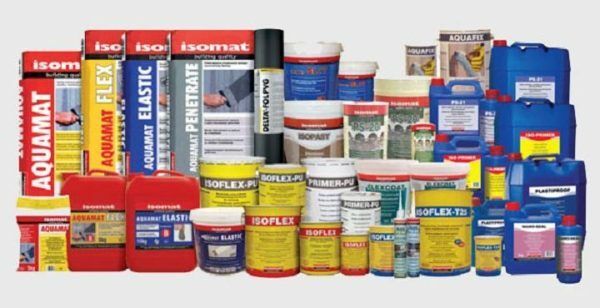
There are many types of moisture barrier material, each of them has its purpose.
Waterproofing material protect structures and buildings from the penetration of moisture, prevent the structure from the ravages of filtering or water washing, and so on. D. In short, waterproofing creates conditions for normal operation of plant and equipment increases reliability and improves durability.
Inexhaustible range - with no idea of the kinds of these products, you can easily get confused. Let's understand the purpose of classification and various types of waterproofing.
Requirements for waterproofing

Waterproofing must be protected from moisture all the elements of the building.
On the various elements of buildings (roof, walls, foundation) affect a variety of environmental conditions. So choose and install some form of waterproofing, on its merits, taking into account these factors.
Sealing material should be resistant to aggressive environmental conditions. It affects their durability and reliability.
Basic quality proofing

Water resistance - the most important characteristic of waterproofing.
In waterproofing should be such qualities:
- impermeability. It is the ability not to miss and do not absorb moisture. This feature - the basic for all kinds of waterproofing materials.
- weathering. This ability to maintain the initial quality of a certain time under different weather phenomena. The parameter is defined in points according to a special scale. Or indicated by the manufacturer in years, months or days.
- Water resistance. Material resistance to prolonged exposure to moisture, without loss of initial quality.
- biological stability. Modern types of proofing should not collapse from the aggressive influence of fungi, bacteria and other harmful microorganisms.
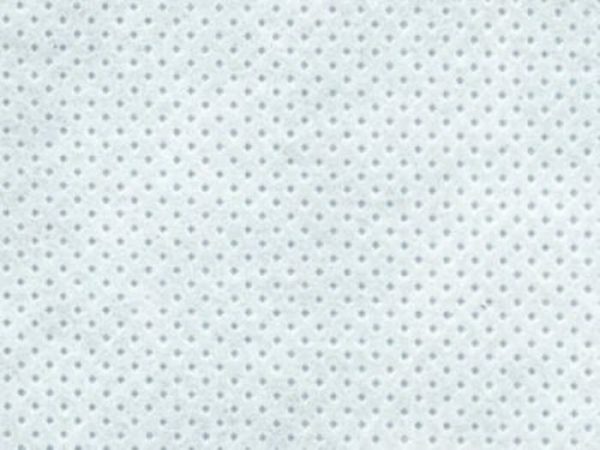
Vapor-permeable membrane retains water, but allows vapor.
- water vapor permeability. The ability of the material to pass through itself water vapor. This quality is especially important for the waterproofing of walls and roofs of buildings.
- Resistance to extreme temperatures and its extremes. The ability of the material to maintain the initial quality and integrity of the structure at a certain temperature regime. In particular, it is important to this property for exterior waterproofing.
- Resistance to mechanical damage. Waterproofing must maintain the integrity of the structure during heavy loads on its surface.
- Durability. The ability of a material to maintain the integrity and quality of work under the influence of aggressive factors of all guaranteed by the manufacturer lifetime.
- Chemical resistance. The ability to maintain its waterproofing properties and integrity under the influence of aggressive chemicals and substances.
As the water shutoff materials classified?
Initially, the classification divides Waterproofing Materials under the terms of their use. On this basis the waterproofing can be used for interior and exterior use.
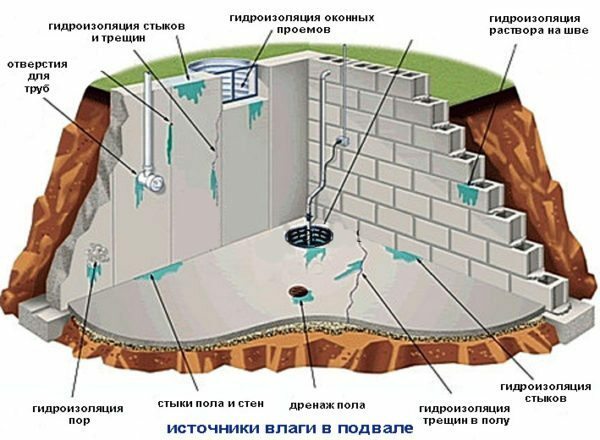
EXAMPLE antifiltratsionnoy proofing complex.
On the main destination There are two types:
- Antifiltratsionnaya waterproofing. Used for protection of underwater and underground structures against water penetration. This may be the basement and cellars of buildings, mines, transport tunnels, caissons, caisson.
- This protection also applies to hydraulic retaining structures - diaphragms, drooping, dams.
- Protects similar material and waste leakage or operating water in swimming pools, canals, tunnels, industrial tanks, sumps, and so forth.
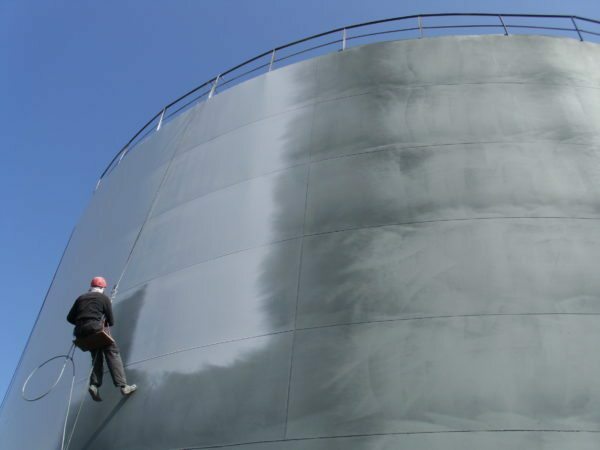
One of the problems of corrosion waterproofing - to protect metal structures from storm water.
- Corrosion waterproofing. It is used to protect the material of buildings and structures from the mineralized rainwater, groundwater, wastewater, river and sea water. it also protects items from chemically aggressive fluids.
- Anticorrosive waterproofing thwarts aggressive and atmospheric effects on portions of water of variable level. It protects there waterworks and ground metal constructions.
- Such flashing materials can be protected from electric corrosion provoked by stray currents. For example, electric poles, pipelines and other surface and underground metallic structures.
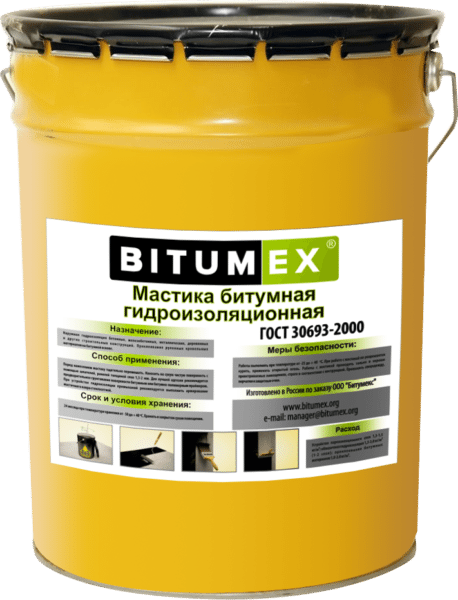
Waterproofing bitumen - one of the most common.
In material production waterproofing may be:
- asphalt (bitumen);
- mineral;
- polymer;
- bitumen-polymer;
- metal;
- consist of bentonite clay.
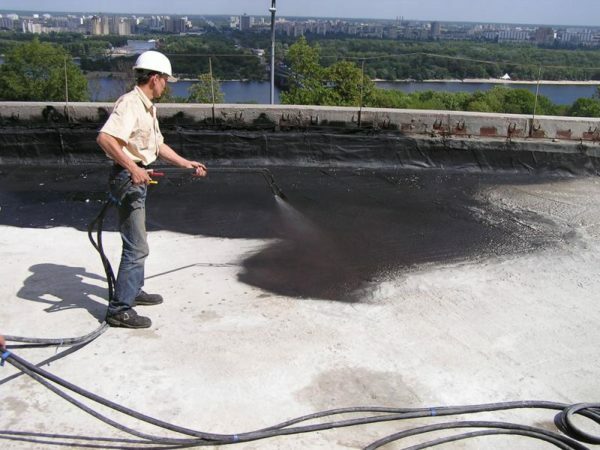
Protection flat roof proofing paint.
By way arrangement waterproofing types are divided into:
- Wood banding;
- painting;
- cast;

Ready-to-use dry mortar for waterproofing.
- plastering (obmazochnye);
- injection;
- impregnation;
- penetrating;
- mounted;
- bulk.
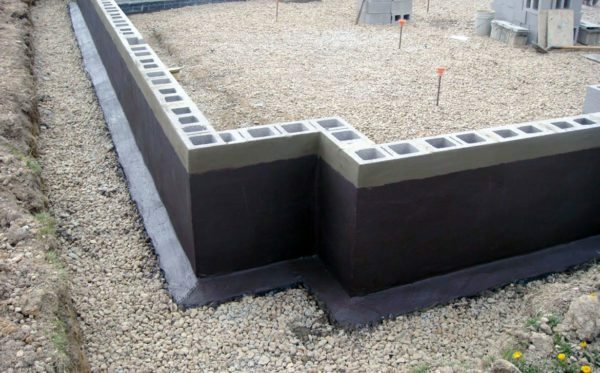
Surface insulation protects the building from the outside thereof.
On design features and intended moisture insulation can be:
- keyway;
- surface;
- a peel or a clamp;
- sealing joints, welds or gateway;
- complex (e.g., plastic compensators gidroteploizolyatsiya).
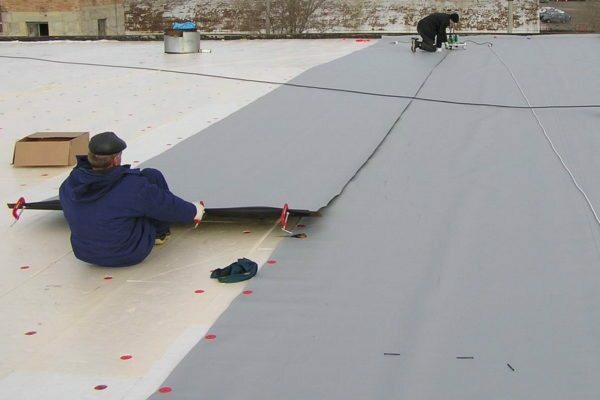
The membranes of polyvinyl chloride are used as roofing materials and waterproofing.
According to the physical condition and the form of waterproofing materials can look like:
- metal sheets;
- Film, fabric, membrane rolls and ribbons;
- flexible sheets (e.g., membranes made of PVC or geosynthetics);
- liquid compositions (Examples - "liquid rubber" sprayed polyurethane);
- dry (powdered) mixes.
Types of damp-proofing materials
I'll tell you more about the types of waterproofing.
Paint insulation
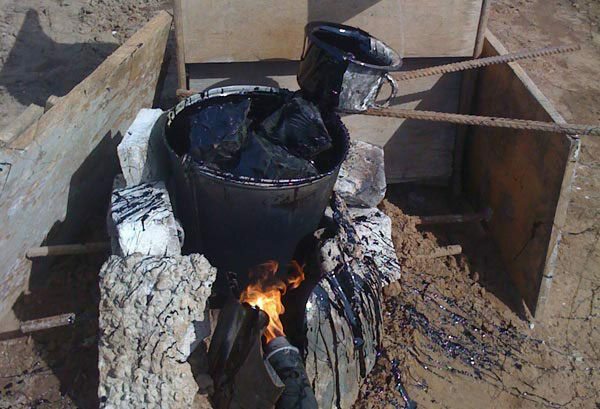
Hot bitumen mastic before use must be heated.
Paint moisture insulation can be cold or hot. It is made as a laminate, but a thin (up to 2 millimeters) coating. It consists of polymer, bitumen or polymer-bitumen paints, varnishes, primers and mastics.
Painting materials for optimal corrosion and insulation protivokapillyarnoy metal and reinforced concrete structures. The most reliable - cold rubbery epoxies and hot polymer-bitumen.
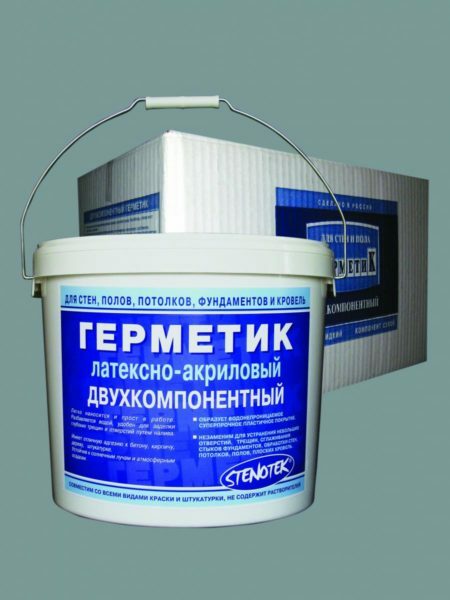
Latex-acrylic coating insulation is universal and can be applied to all elements of the building.
Is now becoming more common started to receive new polymeric coating, applied cold. This primer:
- latex;
- Latex acrylic;
- epoxy;
- epoxy-furan;
- wood tar epoxy and so on.
plastering waterproofing

Moisture insulation plaster is often used to protect the bases.
Obmazochnaya plastering and moisture insulation can be cold or hot. This thick (up to 2 centimeters) a coating applied in multiple layers.
The most common plastering compositions for reinforced concrete structures:
- Cement Gunning;
- cement colloidal solution;
- mastic asphalt and plasters hot and cold drawing.
All of these compositions do not need guards. They enable the mechanization of their installation.
Now it is expanding the use of plaster and surface waterproofing of polymer-concrete and polymer concrete solutions.
Wood banding materials
Okleechnaya isolation - a multilayer (usually 2-3 layers) coating of web materials. It is in most cases protected by plaster, screed or lining.
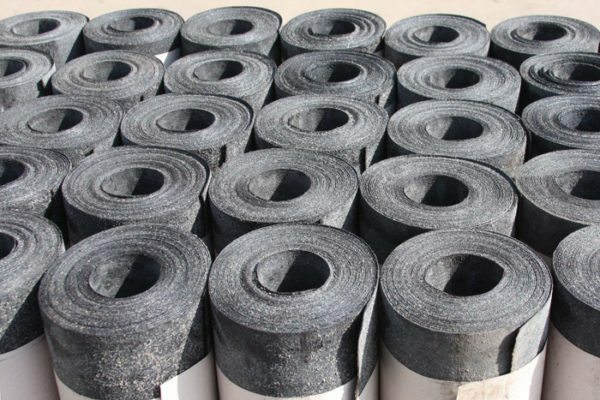
Roofing material for many decades used as roll-lining hydraulic seals.
Traditional Wood banding materials:
- glassine - a rolls of roofing paper impregnated with oil bitumen.
- ruberoid. This material was also made from roofing felt, which is impregnated with a low-melting oil or asphaltic bitumen. Then the cloth is covered on both sides refractory bitumen. Further it sprinkled with talc, asbestos or fine gravel. This protects the material from sticking.
Okleechnaya roofing and waterproofing of glassine is resistant to cracking. However, it is fragile.
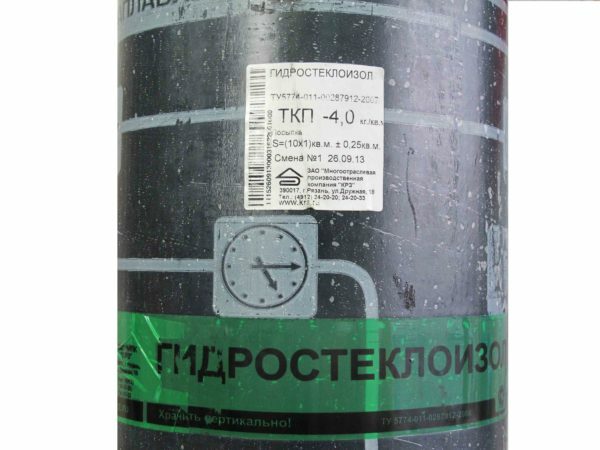
In the photo gidrostekloizol - reliable and durable back-lining material.
So now it is actively replaced by polymer films. Or fiberglass materials and glass fiber coated with bitumen (e.g., flashing, gidrostekloizol).
cast moisture insulation
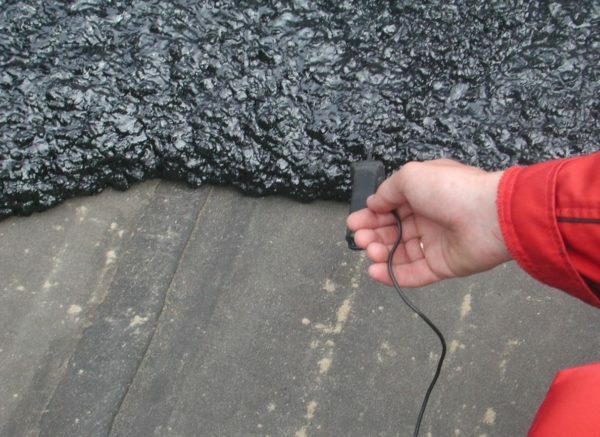
Cast moisture insulation - is an asphalt solution, its thick layer protects the substrate from moisture.
Cast waterproofing - is the most reliable kind of protection from moisture. It consists of solutions or hot asphalt mastics. They are uniformly spread over a horizontal surface in multiple layers. Most often they are two or three. The total thickness of the coating is equal to 2-2.5 cm.
Or the composition is poured into the mold on the walls. Then, the coating layer may be 3-5 cm.
Price cast waterproofing is quite high, and make it difficult. Therefore, it is chosen only in particularly important cases.
advanced materialsWhich have recently been used for cast-proofing:
- bitumoperlit;
- keramzitoasfaltobeton;
- penoepoksid and other kinds of foam.
Bulk moisture protection
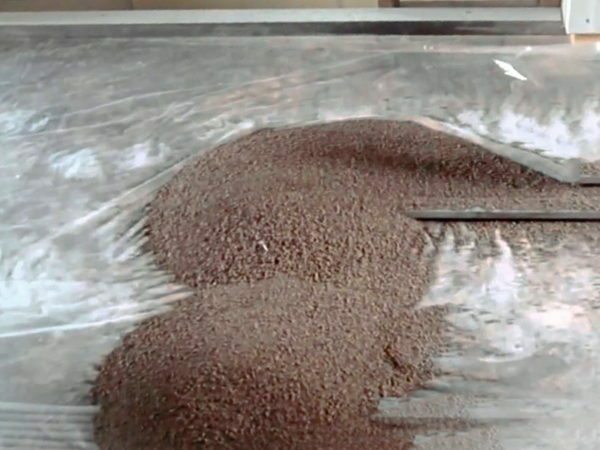
Expanded clay is one of the cheapest materials for waterproofing.
Loose-fill insulation is loose waterproofing materials. They are stacked in layers and watertight cavity. Those most often fenced formwork.
According to the purpose and design of the bulk moisture insulation similar to the cast equivalent. However, it has a large thickness (0.5 meters) and it may serve as an additional thermal insulation at low water resistance.
The most common bulk materials:
- hydrophobic sand;
- expanded clay;
- hydrophobic powders;
- asfaltoizol.
Impregnating compounds
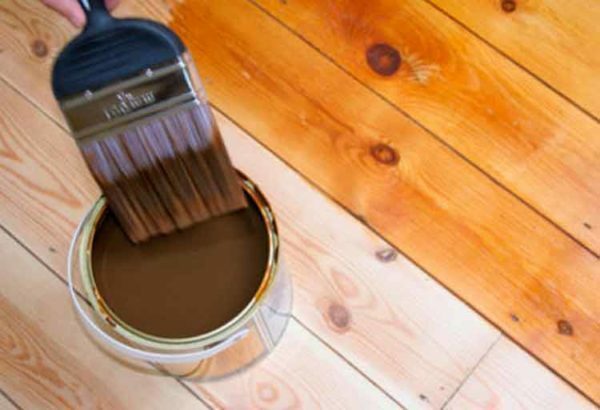
Impregnation of wood flooring polymer primer to increase their moisture resistance.
Impregnating waterproofing materials are used to protect construction products with a porous structure:
- structures made of wood;
- concrete, foamed concrete and gas concrete blocks and slabs;
- asbestos cement pipes and plates;
- limestone and tuff blocks.
Impregnating waterproofing optimal for prefabricated structural components that are exposed to high mechanical loads. It:
- pipes;
- piles;
- foundation blocks;
- tubing.
The most common penetrating Waterproofing composition:
- bitumen in organic solvents;
- petrolatum;
- coal tar pitch;
- polymer primer and varnish.
Injection waterproofing technology
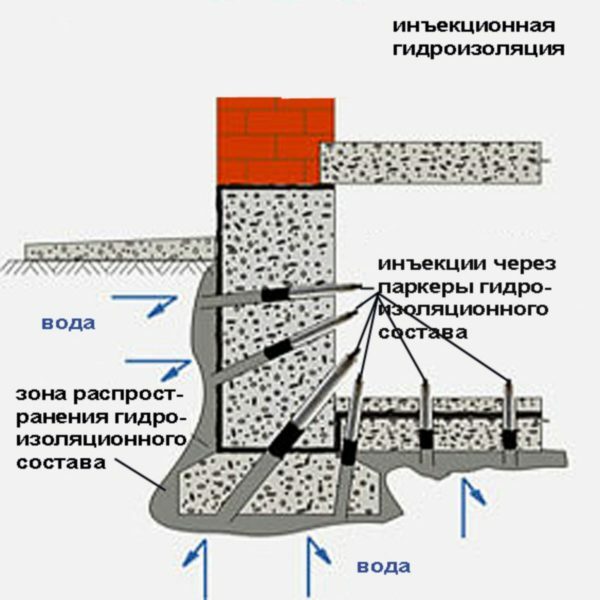
The principle of operation of the injection waterproofing.
Injecting moisture insulation made using injection of binders in the cracks and seams structures. Or in contact with the soil them. It is usually used for waterproofing restoration.
For injection waterproofing is now increasingly used modern types of polymers. This furan resin or urea.
installation materials

Insulation cap mounted with the help of moisture protection.
Mounted waterproofing made of structural elements:
- plastic sheets and webs;
- sheet metal;
- specialized tapes.
They are fixed to the base of the mounting links. Use this isolation in particularly complex cases.
Advanced materials for mounted water protection:
- ethylene-propylene rubber, is laid on the ground or is glued to the solid support;
- fiberglass;
- hard PVC;
- prefabricated reinforced concrete covered with plaster in the factory paint or waterproofing.
The most common type of mounted waterproofing - a surface coating. They are combined with a seal of design, arrangement of expansion joints and couplings. This creates a continuous pressure head protection for buildings.
surface waterproofing
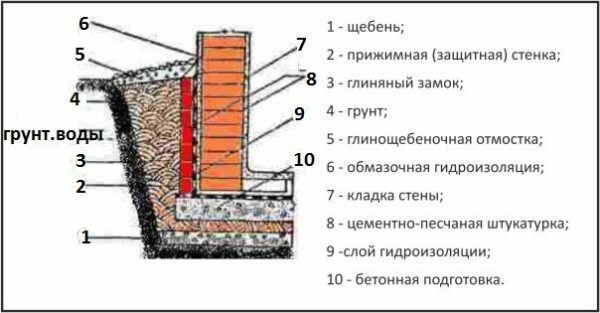
In most cases, the surface moisture protection works on the pressure.
- Traditionally, surface moisture insulation is constructed in the waterproofing work so that it is pressed against the pressure of water to the protected structure.
- Recently there have been a variety of protection, which work on the gap.
Of great importance in the regeneration of the surface has a waterproofing seal expansion joints. This is necessary to make joints watertight and protect them from clogging with ice, soil, floating debris.
In addition to moisture-proof seal must be in a high deformation capacity and flexibility. This helps them to follow the deformations of the abutting sections of structural elements.
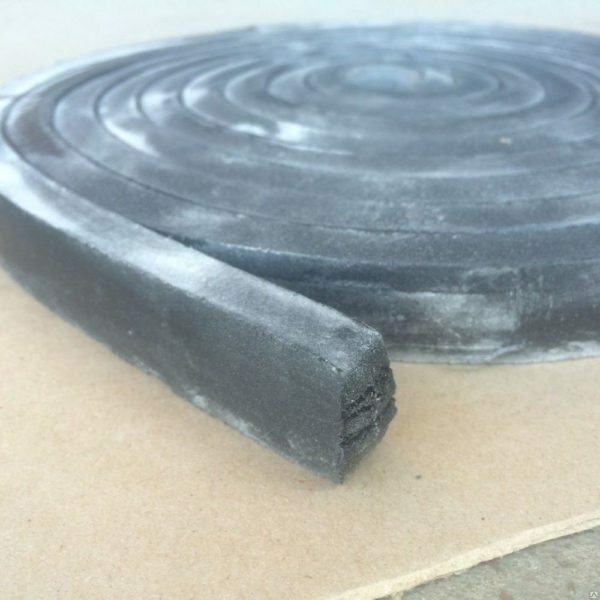
Bentonite cable jointing.
The most common types of seals:
- plastic and rubber diaphragm;
- asphalt pads and keys;
- Linear adhesives in the form of tapes and cords;
- compensators and metal diaphragm.
Recently, there have seals made of fiberglass and polymer-bitumen sealant. They make it possible to equip more reliable and easy sealing.
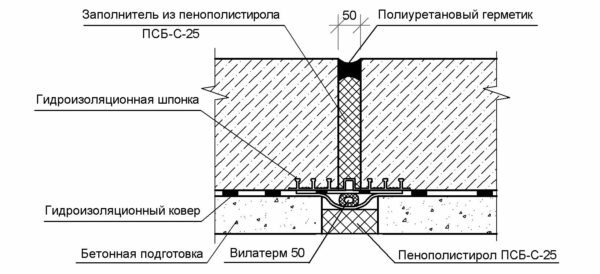
EXAMPLE waterproofing, which runs on the lead.
Isolation, a peel - a cover mounted on the side of the structure, which is the reciprocal pressure water jet.
Scope:
- Restoration, renovation waterproofing of buildings and constructions. For example, using an internal plastering flooded basements.
- Proofing of underground objectsIn which the supporting structures embedded in concrete flush with the bottom of a rocky ground around them. It sunk wells, tunnels, buried much of the room.
The materials used for insulation, a peel:
- Coatings that can be fixed on the base by anchoring. It is mounted and cast waterproofing.
- Coating not lose adhesion to concrete reliable during prolonged exposure to moisture. This epoxy paint and asphalt materials for cold application and cement shotcrete.
penetrating compositions

Penetrating waterproofing protects the underlying structure from moisture layers.
The basis penetrating waterproofing are dry mixture. They consist of quartz sand, cement and chemically active additives.
How does the penetrating waterproofing: Ions supplement, dissolved in water to penetrate into the concrete of its pores. There, they crystallize in the course of a chemical reaction. These ions create a reliable barrier to water:
- Chemical insulator components fall deep into the concrete, dissolves in water. There they react with aluminum and calcium ion complexes, salts and oxides of metals which comprises concrete.
- In these reactions, a formed salt complex composition. In their reaction with water-insoluble crystalline hydrates formed. This randomly arranged acicular crystals.
- Crystalline clog pores, and microcracks capillaries width up to half a millimeter. This new formation becomes part of the concrete structure.
- Due to the forces of surface tension of water, acicular crystals become insurmountable barrier in its path. This blocks the filtration of groundwater through the concrete.
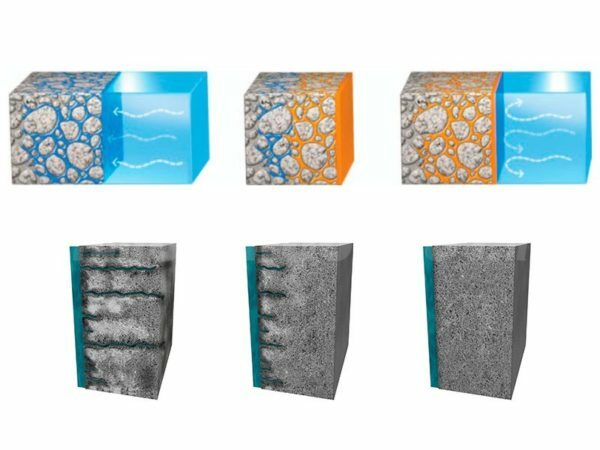
Clogging capillaries penetrating the composition becomes a part of the material that protects.
The period of service of penetrating damp-proofing is the time of operation of concrete structures, which it protects. This happens because the crystalline, ranging in thickness of the concrete and changing its mechanical properties, it becomes a part of it.
Manufacturers instructions indicate that this further enhances the waterproofing base compressive strength.
Evaporation materials
Sprayable waterproofing used to protect against the ingress of water or leakage of:
- foundations;
- roofs;
- cellars and basements:
- artificial reservoirs.
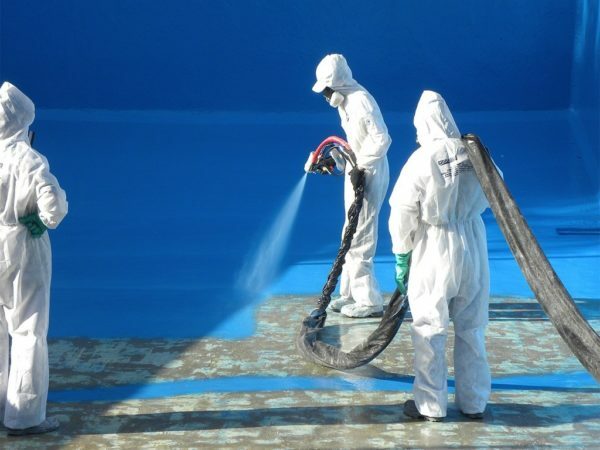
Sprayed coating creates a monolithic membrane impermeable moisture.
This two-component coating which is composed of polymeric base and curing agent. They are mixed prior to application of the insulation. The composition is distributed over the surface of the cold spraying method. After his cure on a protected basis creates a solid membrane.
Advantages sprayed waterproofing:
- good adhesion to any foundation materials;
- monolithic coating, it has no seams;
- non-flammable material;
- it has no smell;
- long service life, about 10-15 years old.
Protect from moisture building elements
I'll tell you in detail about the individual elements of the building waterproofing.
Waterproof basements and foundations
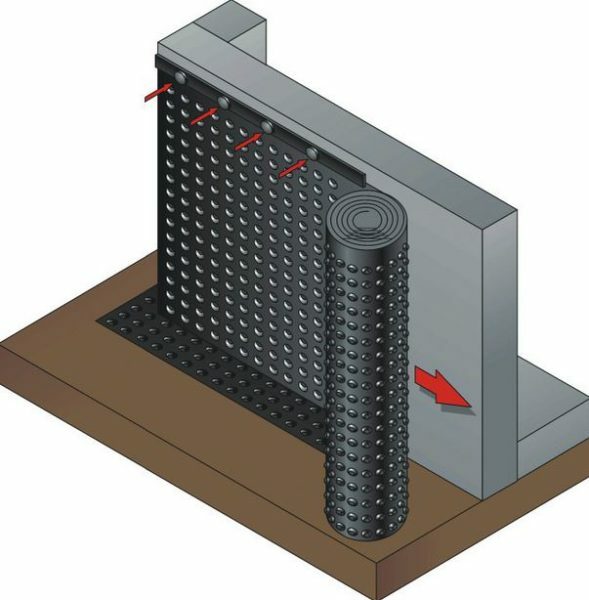
Protection circuit basement waterproofing membrane.
the waterproofing of the foundation with his own hands the work involve the following stages:
- Substrate preparation. Cleansing it from dirt, dust, oil stains.
- Arrangement waterproofing coating.
- If necessary, then mounted guard.
- Sealing couplings and joints of the foundation.
When choosing the type of waterproofing, I recommend that you choose to cover, allowing at the same price and reliability, to mechanize the work and avoid its seasonality.
I warn you, waterproofing basements and foundations - is the most important and complicated stage of construction. My experience shows that eliminating wiring errors waterproofing is much more expensive than just quality to do the job.
For the foundation use different types of moisture protection. Usually rolled waterproofing materials are used. If the ground is problematic, then the optimal solution - the latest injectable counterparts.
Moisture insulation of the foundation must include a seal cold joints. They appear as a result of uneven paving monolithic slabs, due to the appearance of microcracks during soil shrinkage or it interconnects the joints.
Protection of land part of foundations and basements
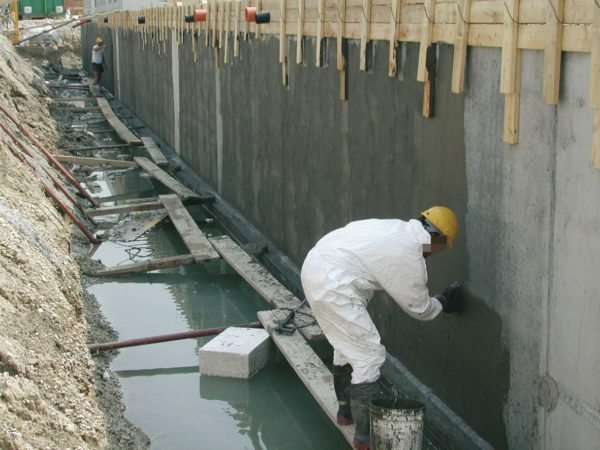
In most cases part of the foundation plinth selected Obmazochnaya moisture insulation.
To make the correct external waterproofing the basement or a basement, you need to take into account the following factors:
- nature of operation of the premises;
- the intensity of the penetration of groundwater, rainwater and meltwater;
- presence and drainage features of its construction.
Moisture aerial parts cellars, basements and foundation in most cases settling lubricative materials. But if groundwater is abundant, and it is impossible to arrange drainage, this method is ineffective. As a result, in the basement there is dampness and mold pockets.
I suggest you a good way out of this situation. Use a drip-proof basement injectable material. Apply it as follows:
- First, in the basement wall from the inner side, drill a series of holes.
- They are pumped by pump acrylate gel.
- The injectable composition begins to actively absorbed by the wall.
- As a result, acrylate goes out and creates on the outside wall of the protective film.
floor insulation
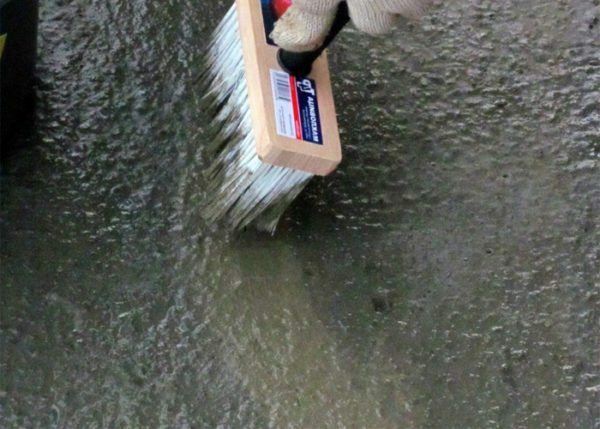
Concrete floor optimal solution - penetrating moisture protection.
For damp-proofing concrete floors often penetrating materials are used. They are effective even for the protection of the basement floors with serious cracks.
But fully guarantee the protection Only web materials of the polymer film. Because of their rating and high. When bonding the joints between them webs insulator create a monolithic barrier impermeable to moisture.
In the bathroom, the bathroom, the kitchen floors are often protected from moisture film or bitumen roll materials. Extended method of spray insulation. Then the floors are covered in several layers of bitumen or polymeric varnishes and mastics.
In waterproofing paint has one serious drawback - a small period of operation. He is 5-6 years.
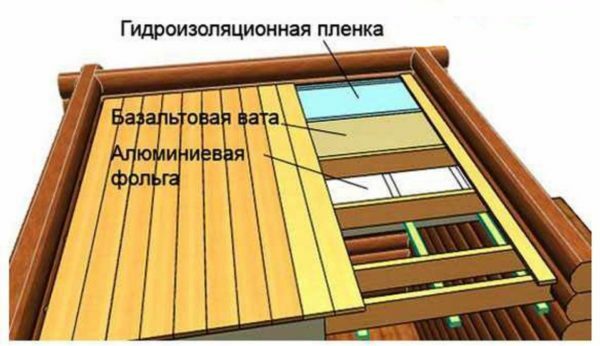
Wooden flooring is best to protect the polymer film.
At moisture protection of wooden floors has two features:
- It is best to equip with the help of the web material from the film. This coating must be continuous and vulnerable joints.
- In places sexes contiguity to the vertical structures (walls, pillars, arches, etc.). Waterproofing should whipped on their surface. The height of the overlap should be about 20 cm.
Protecting the base of the outer walls
Kamnevidnye Porous materials (brick, cellular concrete, limestone, aerated concrete, expanded clay) soil exposed cheese on the capillary suction of water. This leads to a rapid hydration of the walls and their destruction. Moisture freezing in winter repeatedly accelerates this process.
Therefore the walls of the porous base materials needs kamnevidnyh sealed protective cutoff. The optimal option - use a waterproof polymer film. With the help of the first or ground floor is cut off from all the humidified structures: the cap portion underground basement and foundation.

Scheme shutoff proofing injectable composition.
Suitable for cut-off of waterproofing and injection materials.
A common practice for many years a high cut-off marks of cement mortar is ineffective - it simply does not work.
Choke water in such a waterproofing wall repress completely, since the solution has pores. Seasonal cycles of thawing / freezing gradually open capillaries and begin to expand in the protective coating.
This provokes the beginning of the inflow of moisture in the walls of the house. Water completely opens up the pores and starts a process of structural failure.
Output
Waterproofing materials are very diverse. There are a variety of types and varieties intended for the protection of various buildings and building elements. Not familiar with their features, you will not be able to effectively apply the waterproofing.
To clearly understand the topic, watch the video in this article. If you do something that is not clear, ask questions in the comments.


